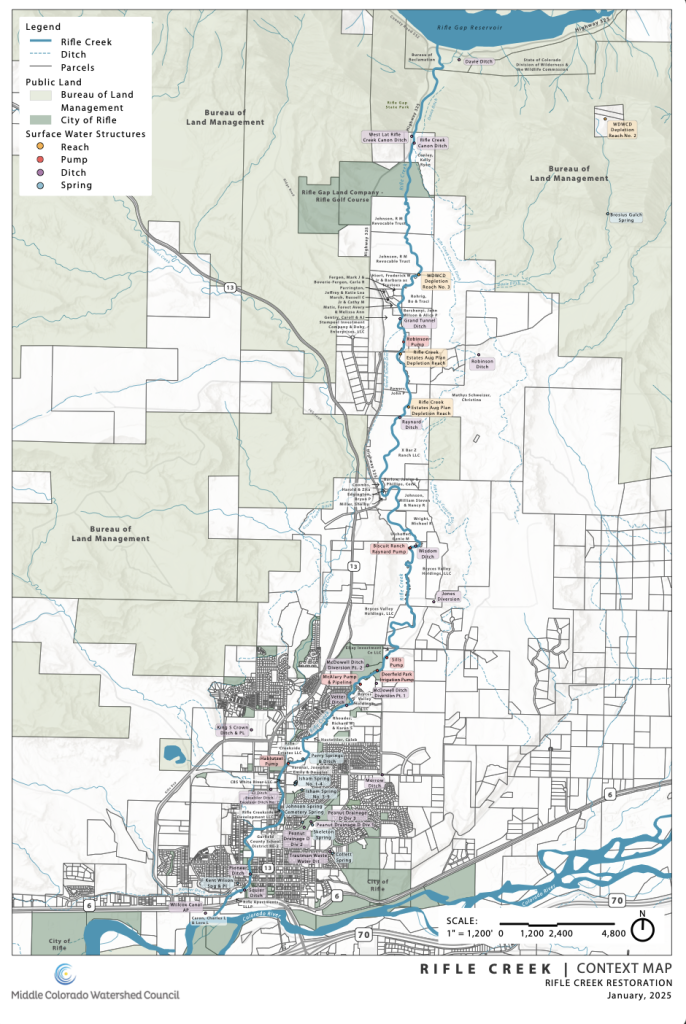Rifle Creek restoration project hopes to make creek ‘asset’ instead of ‘liability’

Rising temperatures, increasing aridification, and degrading stream health are straining the seven-mile stretch of Rifle Creek from the Rifle Gap Reservoir to its confluence with the Colorado River, diminishing benefits the creek has provided since the 1880s.
In partnership with the City of Rifle, Garfield County, the Re-2 School District, the Bureau of Land Management, local ditch companies and private landowners, the Middle Colorado Watershed is ready to kick their Rifle Creek Restoration Implementation Plan into gear.
The plan includes five “tasks” aimed at improving water quality and delivery efficiency, enhancing wildlife habitat, increasing climate resilience, and supporting recreational, agricultural, and municipal usage through the implementation of science-based, shovel-ready restoration projects.

“I’ve talked to some long-standing Rifle residents that dream of the day when they can again sit by the creek and put their feet in the water,” Executive Director of the Middle Colorado Watershed Kate Collins said. “These are public spaces that can really benefit from increased safety and improved aesthetics.”
First task: replacing the Grand Tunnel Ditch Flume
The first task — replacing the undersized Grand Tunnel Ditch Flume — is set to take place during spring 2026, something Collins said would be a simple and reasonably inexpensive way to begin their improvement project.
“The flume that’s in there now is not adequate,’ she said. “It’s a 24-inch flume that needs to be 36-inches… Replacing it will deliver the water much more efficiently, right now the water will back up because of debris and sediment and it becomes a mess. It’s reasonably inexpensive in the world of agricultural water delivery system improvements and the first thing we thought we could get done.”
The replacement will cost an estimated $20,000. The Watershed Council secured $15,000 from the Colorado Water Conservation Board Water Supply Reserve Fund, along with a required 25% match totaling $5,000 from the Grand Valley Ditch Company and the Trout and Salmon Foundation. The 24-inch flume serves 19 water right holders, including the City of Rifle and the Garfield Re-2 School District.
Collins said the investment into ecological and infrastructural improvements will simultaneously incentivize using the creek for agriculture and recreation while also preparing the area for an uncertain environmental future.
“I’ve heard Rifle residents talk about the creek being a liability right now versus an asset,” she said. “We hope that it can become a thing that people can interact with, an accessible part of their parks and open space that they can use.”
She continued to explain that there are also plenty of extenuating circumstances that are putting the creek’s ancient infrastructure in a position that is hard to succeed from.
These circumstances include increased sediment flows from the creeks supplementing Government Creek to the northwest of Rifle Creek, along with inefficient diversions, bank instability and invasive species throughout Rifle Creek. That stress is only further emphasized by historic water rights, and recent increased climate and wildfire pressure.
More restoration tasks gain momentum
The other tasks, currently operating without a timeline though gaining heavy traction, are slated to take throughout the City of Rifle and beyond, with a restoration project planned at Deer Park, channel improvements at Centennial Park, sediment control at Government Creek, and an intake redesign at Wisdom Ditch.
Collins said that she was one of nine people to brainstorm the five tasks during the Growing Water Smart conference hosted by the Sonoran Institute in April in Montrose. From county planners to commissioners and city councilmen, Collins said being able to roll up their sleeves together over the course of 72 hours was one of the best professional experiences of her life.
“It was like a brain trust. In all my working years, it was one of the best professional memories that I have. It was a lot of work, but every single person was so engaged.”
For more information or to get involved with the Middle Colorado Watershed Council, visit midcowatershed.org.

Support Local Journalism

Support Local Journalism
Readers around Glenwood Springs and Garfield County make the Post Independent’s work possible. Your financial contribution supports our efforts to deliver quality, locally relevant journalism.
Now more than ever, your support is critical to help us keep our community informed about the evolving coronavirus pandemic and the impact it is having locally. Every contribution, however large or small, will make a difference.
Each donation will be used exclusively for the development and creation of increased news coverage.









